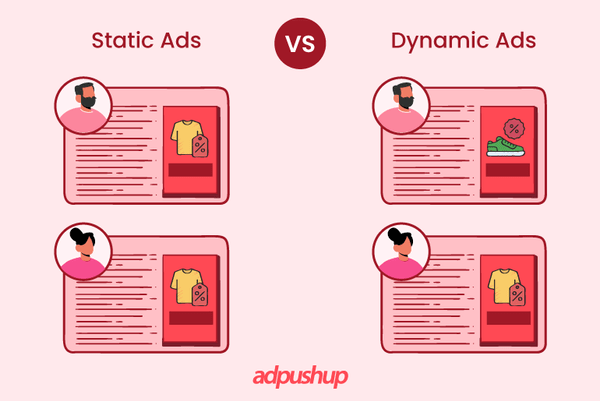In advertising, grabbing attention and prompting action are key. That is what marketers and designers try to achieve while designing an ad’s form, style, genre, colors, and other details.
However, new technologies continue to change every industry including ad creation. Artificial intelligence has become a new tool for developing a visual piece that can attract viewers.
- So how exactly does AI influence creative ad design?
- What can it do and what cannot
- What to expect from artificial intelligence in the future?
Here we’ll closer look into these questions to find answers. If you want to know them too, make sure to read this article till the end!
What is Creative Ad Design?
Any advertisement consists of design and content that must catch viewers’ attention. That is what creative ad design in general is about. While digging further, we can see that it has the following major points:
- Visual design – images, videos, and other illustrations must be exciting and eye-catching. There are many tools, such as a collage maker, that can help you create visually engaging content by combining multiple elements into cohesive and attractive designs, enhancing the overall appeal of your marketing materials.
- Meaning – any advertisement delivers a certain message devoted to the needed topic.
- Call to action – ads encourage viewers to follow instructions, to act.
- Brand identity – advertisements always represent brands, by including logos, specific visual styles, and color palettes.
By accomplishing these pieces, you end with an effective ad. However, each of them has its creative and design processes, which artificial intelligence facilitates.
The Use of AI in Creative Ad Design
Artificial intelligence is a unique powerhouse that has already started transforming marketing and advertising. Its versatility and ability to learn from existing references can provide solutions to even custom requests.
Such possibilities have created a great demand for AI that can optimize creative ad design. As a result, there are already smart tools and services that cope with multiple tasks and transform advertising workflow.
Advertising Efficiency Improvement with AI
To create a successful ad, you must know the current trends, peculiarities of the target audience, brand identity, and campaign objectives. AI algorithms are capable of processing all such data in short terms. Then, it creates a corresponding advert.
From another perspective, such data analysis delivers advertisers valuable information on audience segments, their preferences, behaviors, and demographics. That optimizes traditional designing methods by improving ad accuracy.
AI in Solving Ad Creativity Tasks
Imagination is the unique ability of humankind, which allows coming up with great ideas for different ad solutions. Nevertheless, artificial intelligence can succeed in multiple tasks that require creativity. It analyzes visual content, defines patterns, and engages relevant materials to provide creative ad design.
That is part of AI natural language processing (NLP). It investigates all the peculiarities of how humans use language, slogans, and messages in advertising. That allows for generating a collaborative copy of combined human ideas, which is unique.
By analyzing trends in the media and entertainment industry, AI can further refine its understanding of audience preferences and the effectiveness of different advertising strategies. This insight helps businesses tailor their content to meet evolving consumer expectations and stay ahead in a competitive market. Additionally, staying updated with these trends enables NLP applications to dynamically adjust the generated content, ensuring it resonates with current cultural and social norms.
Modernization of Editing
To deliver the most charming and attractive ad designers often deal with editing. It greatly changed in the last decade, especially with new AI possibilities.
- Automated editing – The process of editing involves multiple steps of different complexity. The minor ones like color correction, removing background, enhancing image quality, etc. can be easily accomplished with artificial intelligence in several clicks.
- Predictive Editing Recommendations – By analyzing designs of previous ads, AI defines patterns, style, branding, and other points that can be optimized.
Check out this example on how they used AI to create ads for their client:
Benefits of AI in Delivering Creative Ads
With the rapid growth of technologies, AI has become extremely versatile. They can deal with a large range of tasks. That results in benefits, which focus on enhancing creative ad design.
Personalization
With the ability to analyze large volumes of data, AI comes up with highly personalized advertisement options. They are tailored to individual preferences, behaviors, and demographics. As a result, it increases the relevance and engagement of target audiences.
Moreover, artificial intelligence can provide forecasts of possible user preferences and develop ad content to match future consumer needs.
Time Optimization
Time is crucial in the process of creative ad design. Artists and marketers take time to investigate trends and come up with solutions. Artificial intelligence can greatly reduce the required time along the entire advertisement creation process.
- Reducing time on brainstorming for slogans, and messages;
- Faster searching and selection of relevant images and materials;
- Shortening target audience data analysis;
- Utilization of template libraries;
- Adaptability to different marketing channels;
- Making assumptions and predictions on future trends.
Competitive Advantage
In the realm of marketing, advertising quality greatly influences the activity of customers. While large companies can easily hire multiple professionals, smaller enterprises may struggle to reach the same ad quality level.
Everything has changed with creative AI ad design solutions. Such technology becomes cheaper and cheaper, ensuring simple accessibility. That leads to enhanced advertising competitiveness.
That leads to enhanced advertising competitiveness. Additionally, the integration of technologies like the rag chatbot has democratized high-level marketing strategies. This rag chatbot can analyze customer interactions and optimize ad content in real time, making it a powerful tool for businesses of all sizes. With tools like the rag chatbot, even small businesses can deliver personalized and compelling advertisements that resonate deeply with their target audience.
Improved Targeting
Addressing the target audience of a brand or product requires collecting and analyzing information. AI greatly optimizes the methodology of targeting and the process itself, especially the following points:
- Segmentation: Allocation of customers to distinct groups based on specific criteria.
- Contextual targeting: Analyzing website content and keywords to provide a corresponding environment for a specific advertisement.
- Real-time optimization: As AI can run automatically, it can create, change, and adapt advertisements based on audience feedback, performance metrics, and advertising campaign goals.
- Dynamic Ads: If you’re running campaigns on various online advertising channels, note that Dynamic ads are the new trend. By creating ad copy and designs, ad platforms like Google and Meta now offer Dynamic Ads, where their algorithm will mix and match the ad image and copy headlines randomly, and through machine learning, figure out what is the most effective combination. AI also analyzes the users’ likes and behavior so it can serve those the audiences the most relevant and effective ads.
Challenges of Artificial Intelligence in Creative Ad Design
Artificial intelligence is a strong tool that levels up creative ad design. Nonetheless, it is not the ultimate solution to every task. AI has its drawbacks and challenges, which limit its usage.
Lack of Data & Experience
Advertisement creation and design tools powered by artificial intelligence still lack experience. They constantly learn from existing data, whose quality varies. That leads to the inaccuracy of required ads. For instance, AI faces difficulties creating anatomically accurate hands, fingers, and other parts of the human body. That reduces the range of images you create.
Additionally, creativity can be the biggest challenge. As AI utilizes information from learning on references and databases, it struggles with delivering original ads with deep storytelling and emotional saturation.
Ethical Concerns
Quite often there are no rules on advertisement. Still, marketers follow certain moral and ethical guidelines. However, artificial intelligence cannot completely grasp such notions. That may result in inappropriate ads that may even harass an audience or violate some social rules.
- Privacy: AI learns from user data for targeting and messaging. While it is often free to access, artificial intelligence may overuse such personal information without any authorization.
- Bias: Learning algorithms do not always select data to represent all the demographic groups. That may lead to unintentional discrimination or unfair targeting in advertising.
Contextual Understanding
Contextual nuances can be crucial for advertising. It changes depending on the product, period of year, audience, or other characteristics. When AI tools create ads, they may not understand such details and fail to accomplish the goal.
- Cultural sensitivity: Algorithms may lack cultural sensitivity and create culturally inappropriate advertising that offends or alienates some audience segments.
- Temporal context: Cultural trends change very fast. Meanwhile, AI learns from the existing information that can be out of date and its creative generation may not fulfill present business goals.
Technical Limitations
With huge learning capabilities, artificial intelligence has technical limitations. That leads to unfulfillment of given tasks, poor quality of results, etc. This weakness includes other different points:
- Training data: Teaching AI requires providing high-quality data, but it can be difficult to obtain it.
- Visual recognition: Ad creation requires understanding images, videos, text, design, color, and other essential elements. While artificial intelligence understands the main details, it faces difficulties with defining visual concepts, styles, cues, and contexts.
- Computational resources: Multiple AI tools offer their services via subscriptions. Installing, teaching, and utilizing such software yourself requires large costs.
Additionally, staying current with the latest trends in the media and entertainment industry is crucial for effectively leveraging AI in these fields.
These trends often dictate the evolution of AI applications and their effectiveness in creative processes. Recognizing and adapting to these trends in the media and entertainment industry can significantly enhance the performance and relevance of AI-driven tools in these sectors.
Perspectives for AI in Creative Advertisement
Creative advertisement design with artificial intelligence will transform in the future. It continues to improve and attain new features to meet the modern world’s needs.
VR/AR Evolution
Virtual reality (VR) and augmented reality (AR) are becoming more and more popular. That creates a space for new approaches in creative ad design. They can use animations and sound to attract the target audience in a flashy way.
While performing online shopping with VR people can get recommendations based on previous purchases. As for AR, marketers can post different ads that people can see at specific locations in their areas.
Content Localization
International purchases become even easier to perform. That encourages marketers to cover multiple languages to attract more customers from abroad. Meanwhile, AI can easily learn languages and create advertisements to match the cultural peculiarities of a certain country.
Colin McDermott, Head of SEO at ecommerce platform Whop says that “AI can be a great way of getting from 0 to 1 with content localization, but is rarely a replacement for human translation from a professional translator. I would always recommend getting a human to check any content before going live with a campaign.“
To Sum Up
Artificial intelligence is a modern versatile tool that changes different industries. In terms of creative ad design, it can solve numerous tasks. It is crucial to remember that AI is not perfect. Nevertheless, it actively evolves reaching new standards of quality. Thus, it can play a significant role in creative ad design nowadays and in the future.
About Guest Author
Dmytro Sokhach is an entrepreneur and the 6-Figure Flipper Club member. Founded Admix Global (web agency) that builds websites, makes them profitable, and sells them as business.













